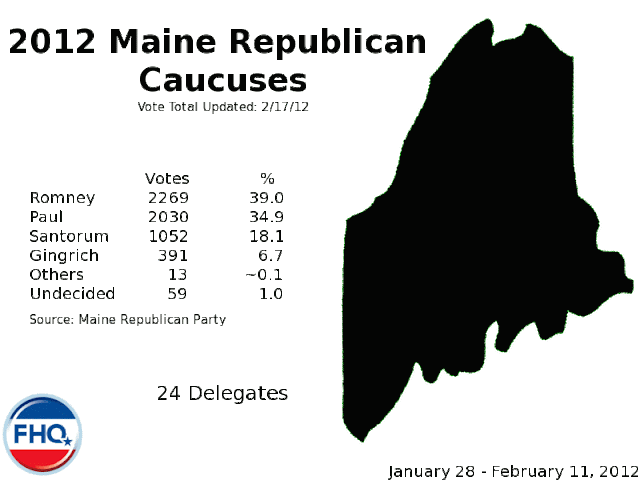Source:
Contest Delegates (via contest results and rules, and RNC)
Automatic Delegates (Democratic Convention Watch)
Delegate breakdown (post-CT, DE, NY, PA & RI primaries):
Changes since Minnesota and Missouri district conventions (4/21/12):
- Romney: +150 delegates (New York: +92, Connecticut: +25, Delaware: +17, Rhode Island: +12, Pennsylvania: +3, Virgin Islands: +1)
- Santorum: +/- 0 delegates
- Paul: +4 delegates (Rhode Island: +4)
- Gingrich: +/- 0 delegates
1) It should be noted that the delegates are difficult to classify in both Nevada and Vermont as both sets of automatic delegates are bound and proportionally allocated with either all of the delegates (Nevada) or with the at-large delegates (Vermont). Those six delegates are in the bound/pledged category in the spreadsheet above but are considered "contest delegates" in the bar chart at the top. It would not be surprising to see those six delegates among those who signed pledges to Romney at the RNC meeting in Scottsdale this past week when and if that list is made public.
2) Mitt Romney swept the delegates in New York (statewide and across all 29 congressional districts), Connecticut (statewide and across all 5 congressional districts) and Delaware.
3) In Rhode Island, Mitt Romney won 63% of the vote and 75% of the total, non-automatic delegates at stake. Ron Paul won 24% of the vote and qualified for delegates by surpassing the 15% threshold for receiving delegates. That netted the Texas congressman 4 delegates; 25% of the total, non-automatic delegates.
4) Pennsylvania is a bit tricky. Though delegates are unbound, some have expressed a presidential preference. The Romney site points to previous endorsements from three delegates directly elected in the primary on Tuesday (see Gerlach, Shuster and English). Additionally, the Ron Paul site has an official list of Pennsylvania delegates that identifies five of the 59 delegates elected on Tuesday are aligned with Paul. The Newt Gingrich site has no such endorsements. However, Gingrich-related sites do have lists of delegates aligned with those candidates. There is also another fabulous thread on another conservative site that breaks this down in even greater detail. The numbers there do jibe well with the Romney, Paul and Gingrich site endorsements. That count -- which FHQ will wait until it is independently verified -- would yield Romney 26 delegates (which counts the four in the spread sheet above), Paul 5, Gingrich 3 and Santorum 2 (or 3). Another 12 or 13 delegates are uncommitted while 10 more are county party-endorsed candidates, former national delegates or alternates or elected officials. That latter group is obviously made up of more establishment/elite figures within the Pennsylvania Republican Party.
5) Mitt Romney has also picked up the lone remaining uncommitted delegate (of two originally) in the Virgin Islands, giving the former Massachusetts governor 8 total delegates in the territory. Thanks to Matthew Wilder Tanner for the link.
6) Two of the unpledged delegates coming out of the Colorado conventions a week ago are Ron Paul supporters. Don't be surprised when and if more of the other 12 unpledged Colorado delegates reveal themselves to be aligned with Paul. If anyone has links to any of these delegates revealing their preferences, please feel free to forward them to me in the comments section.
7) The allocation of the delegates in Georgia is based on the most recent vote returns published online by the office of the Georgia Secretary of State. The allocation here differs from the RNC allocation in Georgia. The above grants Gingrich one additional delegate (which has been taken from Romney's total). Due to the way the Georgia Republican Party rounds fractional delegates, the FHQ count was off by one delegate (+Romney/-Gingrich). The congressional district count is unaffected (Gingrich 31, Romney, 8 and Santorum 3), but the way the at-large delegates are allocated to Gingrich and Romney -- the only candidates over 20% statewide -- is a bit quirky. Gingrich's portion of the vote would have entitled him to 14.6 delegates and Romney's 8.0. Under Georgia Republican rules, Gingrich is given 14 delegates and Romney 8. That leaves nine delegates unclaimed because the remaining candidates did not clear the 20% threshold. The candidate with the highest "remainder" is awarded the first delegate and the candidates over 20% trade turns until all of those delegates are allocated. Remember, Gingrich did not round up to 15 delegates (14.6), but that 0.6 gives him a larger "remainder" than Romney. The former speaker, then, is allocated the first of nine delegates. With an odd number of delegates leftover, Gingrich would have a fifth turn after Romney's fourth and that would end the allocation of those "extra" delegates. Gingrich would claim five to Romney's four. Of the 31 at-large delegates, Gingrich is allocated 19 and Romney 12. Please note that for winning the statewide vote, Gingrich is allocated the three automatic delegates. That makes the final allocation Gingrich 53, Romney 20 and Santorum 3. The RNC, though, has a different interpretation.
Recent Posts:
A Few Notes on the RNC Meeting and the 2016 Rules
2012 Republican Delegate Allocation: Pennsylvania
2012 Republican Delegate Allocation: Delaware
Are you following FHQ on Twitter, Google+ and Facebook? Click on the links to join in.

.png)
.png)
.png)
.png)
.png)
.png)
.png)
.png)

.png)




.png)


